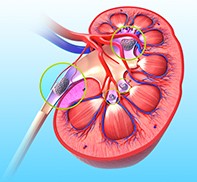Adult urinary stone disease: a practical approach and management guide
Urinary stone disease (nephrolithiasis) is a common medical condition affecting between 4 and 8% of the Australian population at any one time. The reported lifetime risk of developing urinary stones is one in 10 for Australian men and one in 35 for Australian women. Several factors increase the likelihood of developing urinary stones, such as increasing age, a family history of stone formation or certain genetic disorders, and a history of systemic medical conditions such as diabetes. After a history of urinary stone, the risk of developing a second stone is approximately 5 to 10% each year. Up to 50% of people with a first urinary stone will develop a second one within five years. With the prevalence of stone disease increasing, it is likely that the healthcare costs associated with diagnosis, treatment and follow up of patients with stones will rise.
Picture credit: © Pixologic/Deposit Photos.

